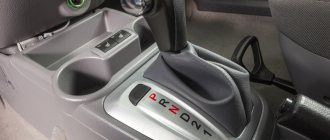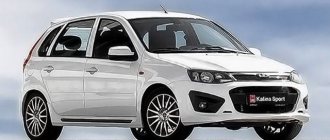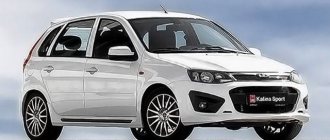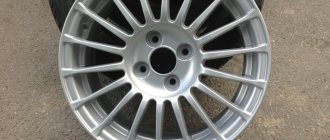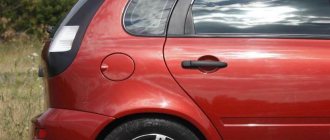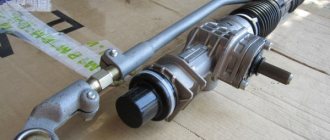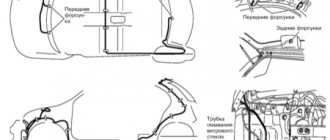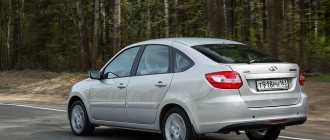Put your smiles aside, this time it's serious. Put your smiles aside, this time it's serious. There are no “ Chinese ” showering the racing asphalt with unnecessary spare parts, no jokes on the topic “it will fall apart or not,” and we even selected the composition of the participants as evenly as possible. Because we really wonder whether the rare supposedly sporty “Kalina” will be able to outpace foreign cars of comparable strength, which are driving half of the country.
They danced, of course, from the power. Under the hood of the Togliatti hot hatch (let's be kind to it and use this term) there is a 1.6-liter naturally aspirated engine, pumped up to 118 horsepower. In combination with a shortened main pair of five-speed manual transmission, this engine is capable of accelerating the Kalina to 100 km/h in just nine and a half seconds. By Zhiguli standards - fire! Exactly the same dynamics are announced for the Skoda Rapid liftback, equipped with a 1.4 turbocharged engine (125 hp) and a seven-speed DSG “robot”.
The three-pedal and six-speed Hyundai Solaris is more vegetable according to the passport: 10.3 to hundreds for the version with a 123-horsepower 1.6-liter engine. Things are even worse for the Kia Rio with the same engine, but with a six-speed automatic transmission - eleven point two. Why do we need two essentially identical cars with different transmissions, you ask? Well, first of all, we couldn’t help but invite Rio - after all, the winner of the last competition . And secondly, at the same time we’ll find out how much the “automatic” actually spoils the racing raspberry. Otherwise, Porsche practically no longer produces cars with manual transmissions, because their PDK shifts better than professional pilots. Maybe something similar is starting to happen in the budget segment?
To give “Kalina” the maximum chance of success, we called a person who was familiar with sports “basins” first-hand to roll out the test quartet. This is Efim Gantmakher , a pilot of the Goltsova Racing team, racing in the same-looking hatchback in the “National” class of the RSKG racing series.
In the city, “Kalina” regularly pretends to be a real lighter. It is clear that the guts of its combat vehicle are completely different, but the “civilian” Kalina Sport also differs quite seriously from the usual one. It's not just about the right daring body kit and a dressed-up interior with creepy, high-standing seats that push your back out. There’s a modified engine with “its own” camshafts and exhaust manifold, and a fervently rumbling direct-flow exhaust, and consider it a completely different chassis: geometry, ground clearance, springs, shock absorbers, brakes, wheels, that’s all.
In the city, “Kalina” regularly turns out to be a real lighter: it accelerates quickly, readily responds to the steering wheel, holds on to the road with all its strength in turns and, of course, shamelessly shakes out of its riders everything that is poorly secured. It seems that two “Koreans” and one “Czech” do not have a single chance: Lada looks like a favorite on paper and feels the same. And in the tight, tight corners of the Smolensk highway, the evil chassis settings, in theory, should not leave rivals a single chance. It turns out that the world is about to turn upside down, and the Russian car will finally defeat foreign cars?
To find out the result of the test, pour yourself a glass of water right now. Managed? Right. This is because the world never turned upside down.
Driven by Gantmakher, the Lada Kalina Sport completed a full (this time without a retarder) lap around the Smolensk Ring in 2:04.539 and confidently took last place in the final table. How did this happen? Let's ask Efim.
“It has nothing in common with what we ride in the RSKG. The settings are not the same at all. The camber on the rear axle is too strong, which prevents me from throwing the stern even a little in turns - and this is necessary on front-wheel drive vehicles. The suspension is heavily compressed, but the body itself is still soft, and as a result, the car still warps when cornering. Plus there are very heavy wheels, because of which both the speed and the accuracy of the trajectory are lost on the curbs. The transmission has been “shortened”, but not enough: the gears are too long, and the engine lives only at the top, so a lot of time is lost when exiting the hairpins. At first I liked the brakes because they were tenacious, but they gave up after two laps - there’s simply nothing to do with them on the track.”
Destruction? Well, not really. Here are some statistics for you. According to the results of the last test, the fastest was the Kia Rio, which brought the second place (Renault Logan) a solid four seconds, and the Datsun on-DO, which is related to the Kalina, even five. And now the Korean bestseller has taken only third place, and with a tiny gap from Kalina Sport - less than four tenths of a second. The best lap of the Gantmakher-Rio pair was recorded at 2:04.174.
Efim had no complaints about the car’s settings - the Rio brakes and turns exactly as needed, allowing you to smartly redistribute weight and play with the rear axle. But when quoting a driver’s review of a six-speed automatic transmission, we need to be very careful so that we don’t get closed for obscenity. In short, the gearbox is lazy, slow and steals a significant portion of the power from a rather peppy engine. Moreover, it often refuses to engage downshifts even in forced manual mode. But last time Ivan Samarin used the same epithets against Chinese transmissions, while heartily praising the Korean one! Everything is learned by comparison, yes, yes.
Preface
The development of a new urban sports car was carried out by a separate division of AvtoVAZ - the Sports Car Department (USA).
Cars here are developed jointly with engineers from the French auto giant Renault and are produced in small series - on average, 2,500 cars are planned to be produced per year, so it is practically handmade. But the 2015 cars were distinguished by frankly poor quality assembly - uneven painting in many places, gaps between the body and the plastic body kit, poorly secured elements and not fully tightened fasteners caused dissatisfaction among buyers.
Nevertheless, Kalina Sport has its own target audience - even despite the fact that among many street racers the very phrase Lada Sport evokes a frank and cynical grin.
Exterior
Although the Lada Kalina 2 Sport is based on a regular hatchback, visually it is clearly different from its prototype. First of all, the car has a ground clearance lowered to 150 mm, and this despite the fact that instead of stock 14-inch wheels, full-size 16-inch ones are installed, so the developers had to slightly change the design of the wheel arches. But the paradox is that the spare tire in the trunk is of a completely different size - 15 inches.
Interior
A sports car must have a specialized interior. But the VAZ USA apparently decided that abundant red thread stitching on everything possible (starting from the cover on the gearbox slide and ending with the upholstery of the seats) is all that the driver needs. Well, some minor changes: leather steering wheel, logos on the seats, and so on.
Motor and transmission
But the most important difference between the Kalina 2 Sport is the engine.
For this model, they did not develop the engine from scratch, nor did they use ready-made products from the same Renault-Nissan, with which AvtoVAZ closely cooperates. Therefore, the “Prior” four-cylinder in-line sixteen-valve engine was used as a source, which underwent serious modernization.
It featured a completely different camshaft with higher cams, an improved performance exhaust manifold, and a completely different fuel injection control system. All this made it possible to increase power to 114 hp. and torque up to 150 Nm versus 106 hp. and 148 Nm for the old engine.
Handling and suspension
Like the rest of the car, the suspension evokes mixed feelings. It is quite energy-intensive and performs well on the track, although a number of elements need improvement: the silent blocks are too soft and the outdated front suspension with thin arms. Here, stiffer triangular-type A-arms would look better, as on most imported B and C class cars.
Review of VAZ Sport 1.4 16V (2009)
ABOUT CHOICE
I decided to exchange the old “ten” for a new car: I was tired of wrapping myself around the steering wheel when parking and sweating in traffic jams in the summer. The conditions for the change were simple: the price was within 400 kilo rubles with all associated costs (additional equipment, insurance, etc.). At the same time, the power is as close to 100 hp as possible. “from below” (a compromise between the minimum transport tax rate and dynamics), not terrible appearance and interior trim, the mandatory presence of air conditioning and power steering. It was desirable to get ABS, airbags and, if possible, the small pleasures of life like alloy wheels, metallic paint and full power accessories. At the same time, not Chinese.
I was not too lazy to walk around the showrooms, feeling all the available options. All foreign cars (and there are only a few of them in the indicated amount) have some disadvantages that clearly do not suit me. Everything that fit into 400K killed at least with its poor interior and appearance (and Nexia - in addition, with cramped conditions and an even more crooked assembly than that of the VAZ).
Thus, the choice came down to VAZ models. At first I gave preference to the luxury Priora. The previous “ten” was generally fine with me, but the things I had the most complaints about (large rolls in corners, lack of power steering and air conditioning, a rather boring interior, terrible body clearances) were corrected on the Priora. Until recently, I sincerely despised “Kalina” and called it nothing more than “FEKalina”.
My attitude changed after visiting the salon. "Kalina" in equal mince is a ton of green cheaper, more spacious inside (especially in the front), better in terms of bodywork (I examined several of them: the gaps on all of them are perfect, and the doors can be closed with your finger - in terms of gaps and the Priora everything is fine, but the doors are tighter). And at the same time - shorter (especially the hatchback), which is convenient for parking. And the mirrors are simply a miracle (of the ones I've driven, only the KIA Cee'd has the best visibility).
In the end, I settled on the luxury Kalina hatchback (the sedan is ugly, the station wagon is practical, but inexpressive - why should it have had taillights like the hatch?). Only two things confused me: a slurred gearbox with a sticking second gear and 4 turns of the steering wheel “from lock to lock.”
And so I come to the chosen salon (in others I didn’t like either the attitude of the managers, or the price of special stages and the obvious wiring for them) to buy a hatchback in configuration 33-016 - and I’m upset to learn that they are not available now. But there is a hatchback in configuration 33-076 - “Kalina Sport”. Previously, I didn’t pay attention to “Sport” due to the lack of airbags, but due to the lack of the desired version, I decided to take a closer look. And in many ways the machine simply captivated me.
Externally, the car is incomparably more expressive than the standard “Kalina” - thanks to the spoiler and other bumpers, as well as the original alloy wheels (not “cast on ot…s”, as on “civilian” cars, but quite nice wheels). The spare tire, by the way, unlike “civilian” cars, is also cast. Much more interesting fabric trim, more comfortable front seats (harder than standard ones, but with a more comfortable profile). The dark interior was a little disappointing with its color (the light one, to my taste, is more pleasant - although, admittedly, the new upholstery would have looked worse in it). But I was pleased by the absence of a phenolic odor, which was pronounced on all previously examined Kalinas and Priors (is it really possible that “sports” plastic differs not only in color, but also in quality?).
The main thing is the gearbox and steering wheel. I don’t know whether “Sport” specifically selects boxes assembled with straight limbs or just luck, but in comparison with all the other “Kalinas” that I tried in three different salons, it’s heaven and earth. All gears are switched on clearly, from the second there is not the slightest problem. It’s a little tight, it’s true (although it’s lighter than on regular Kalinas), but after running in it will probably become softer. Now about the steering wheel. Short rack (3.1 turns instead of 4.2) and Korean EUR. Thus, my two main complaints about the Kalina have disappeared: both the gearbox and the steering are quite adequate. But it’s a shame that you had to pay for it with the lack of airbags.
FACTORY AND DEALER PROBLEMS
Surprisingly, there were practically no obvious complaints against the VAZ itself: a dead glass washer fuse (which, in fact, should have been replaced during pre-sale in the showroom, i.e., actually the seller’s jamb) - and that’s all.
However, there are shortcomings not in terms of obvious inoperability, but in terms of quality:
— the windshield wipers are simply disgusting (they are squeaky, and in cold weather they clean like crazy: at -20, with the interior warm and the washer nozzles thawed out, the driver’s windshield wipers jerkily slide across the glass - however, they have already been purchased by Champion);
— the cooling fan vibrates strongly and makes a noticeable noise when turned on (on the old “ten” only the “left” fan behaved like it died in a couple of weeks);
But there are many more complaints about the car dealership:
— the speaker was installed incorrectly in the driver’s door (the wires were broken when the window was lowered), while the door trim was poorly secured (cricket);
— when installing the alarm, they cut off the standard central locking on the driver’s door (hello, the instrument “beeping” when you turn on the ignition!) and unsuccessfully selected the ignition backup operating mode (in order for the engine to turn off when you turn the key, and not from the key fob, you have to turn off the ignition with the gear on and off handbrake);
— the reported “universal” mats fit the “Kalina” like a cow’s saddle: if the front, albeit with tension, is tolerable (“the third grade is not a defect”), then the back is completely out of size;
- we regretted 10 cm of wiring for the rear speakers - once one of the speakers had already broken off when a friend who was driving us lifted the shelf.
In general, there is no particular crime (the speaker was fixed with an apology the next day, everything else can also be solved with minimal effort), but still not very pleasant.
DRIVING IMPRESSIONS
First of all, there’s a quiet buzz from the suspension. It’s great: the “tenth” is even more comfortable, but at the same time it rolls slightly less in turns, allowing you to take them about 10 km/h faster with the same handling. The only negative is that it shakes on small things at low speeds.
Secondly, very pleasant impressions of the engine. Even on the stock firmware, it pulls significantly better from the bottom than the “tenth” 1.5 16V. It’s still being run-in, so I haven’t tried it at the top, but up to 3000 the traction suits me, and according to all the reviews above, it’s much better. By the way, at -21, after almost a week of inactivity, the car started up the first time.
The brakes, compared to 21103 (even after replacing the brakes and pads), are very good: if you press the pedal well, the car literally stands up. But at the same time, there is no excessive sharpness characteristic of foreign cars, when a pedal pressed an extra millimeter makes the car nod even when you just want to smoothly slow down (I really didn’t like the brakes of my friends’ KIA Cee’d and Opel Zafira).
The mirrors, as I said above, are also excellent: EVERYTHING is visible, and there is no mirror shaking characteristic of mechanical or cable drives in some engine modes.
Complaints on the move come down mainly to excessive noise and vibration load - according to reviews from 1.4, I expected better in this regard (especially in terms of vibrations, the noise is still less than on 21103). Also slightly annoying is the heating of the right foot from the catalytic collector - now, in winter, it’s normal, but in summer?
FAQ TO PREVENT FLOODING IN COMMENTS
1. I understand that the real “sport” of this version of “Kalina” is like Calcutta on all fours. In reality, this is, in fact, a “civilian” Kalina, brought to mind, into which the stupid market idiots did not think to install airbags.
2. One of the main reasons why I chose the VAZ (besides the price, finishing and stuffing) was my low annual mileage (about 10 thousand km). I plan to use the car for at least 4 years, and up to 50 thousand VAZs, according to the experience of all my friends and myself, almost never cause serious problems. If I traveled at least twice as much per year, I would probably spit on the exterior and interior and take the Logan, which is still generally considered more reliable. But for a specific situation with specific short runs of 90% in the city, Kalina seems to me a more attractive option.
3. The review will be updated as the mileage progresses. Because I drive a little, so I was lazy to wait several months at least until TO-1, so I posted it almost immediately.
Video
The domestic auto industry never ceases to amaze. For example: when the Russian press first said that AvtoVAZ was preparing a “sports” version of the second Lada Kalina in a hatchback body, it was more difficult to get a new product for a test drive than another Bentley or Mercedes. Amazing, right? For VAZ people there is nothing special in this: not many significant new products are released, after all, there is no point in the press sniffing out everything ahead of time. And the model with the Sport prefix is really significant, and AvtoVAZ tried its best to prove it. Like, our “sporty” Kalina is really different from its “donor”, it’s not some kind of collective farm tuning! In short, drive for little money. Find out more about it in our review!
Design
Design
Structurally, the car has not changed, but the chassis settings are different. The photo shows that the supports of the front pillars were moved back - the so-called castor increased to 3 degrees. In static conditions, the camber of the front wheels is -30″, and the camber of the rear wheels is -2.5 degrees. To avoid contact of the wheels with the arches, AvtoVAZ engineers limited the travel of the steering rack. Several companies were involved in the production of gas-filled shock absorbers for Kalina Sport. The stiffness of the springs and shock absorbers is higher than usual, with a different ratio of rebound and compression forces. The spring cups of the rear shock absorbers (photo on the right) are raised to accommodate sixteen-inch wheels. The front brake discs reach 280 mm in diameter, and the rear ones – 240 mm.
Adaptation to Russian conditions
Without a doubt, Kalina Sport with its 15-centimeter ground clearance is an exclusively city car, and quite ordinary by the standards of the global automobile industry. In the city, its chassis behaves as if it were firmly built, but on the race track it lacks rigidity - during sharp deceleration, the front axle begins to sway. This deficiency is corrected by smooth braking. The Russian winter is not scary for this Kalina: fortunately, the side mirrors, the 1st row seats, and the windshield are heated. And besides, it has a fairly effective climate system - also known as automatic air conditioning. In addition, the car is equipped with additional sound insulation and a spare tire - 14-inch steel or 15-inch on a cast wheel, depending on the configuration.
Comfort
Safety
The list of “safe” equipment for the sports “Kalina” is short. The initial configuration cannot boast of anything except two airbags for the driver and passenger, mounts for child seats and several electronic assistants. Available electronic aids include an anti-lock braking system (ABS), as well as emergency brake assist (BAS) and brake force distribution (EBD). The top version is complemented by rear parking sensors and rain and light sensors.
Multimedia
On the center console of Kalina Sport there is a radio with four speakers, a slot for SD cards, Bluetooth wireless protocol, a USB connector for connecting mobile devices and a Handsfree function for telephone conversations in hands-free mode. There is no rear video view, no navigation, much less compatibility with iPhones - even for an extra charge, which, however, is forgivable for a mid-budget car. The standard radio does not boast high sound quality, but for motorists with unpretentious taste it is quite suitable.
Lada Kalina Sport Technical characteristics
The hatchback is driven by a 1.6-liter 16-valve petrol engine, available in two power options. The first option develops 106 hp. and 148 Nm, and the second produces 114 hp. and 150 Nm. The engine is boosted to 114 hp. thanks to different camshafts (the lift of the intake valves is 9.55 mm, and the exhaust valves are 9.15 mm), a direct-flow exhaust with a non-standard exhaust manifold (pictured on the right) and a new control program. Both options are combined with a five-speed manual transmission. The gear ratios of the manual transmission of the “sports” model are the same as those of the simple Kalina, but there is one difference - the main gear has been shortened from 3.7 to 4.3. According to the manufacturer, average fuel consumption ranges from 6.7 to 8.6 liters. per 100 km, depending on the modification, and the manufacturer recommends using only 95-grade gasoline.
New improvements compared to the previous model
This car has a temperamental character. Kalina Sport was created for those who love an active life. The target audience is young people who are inclined to have a positive perception of everything around them. Lada Kalina Sport has a rather impressive appearance thanks to front and rear body kits, an aerodynamic spoiler and side skirts.
All these are features of the aggressive, sporty nature of the car. The car is equipped with wheels of quite impressive diameter, which allows you to get an appropriate response when driving it. The designers decided to complement the interior with a stylish ergonomic steering wheel, which allows the driver to feel like a real racer. We paid attention to the seats, which are made in a sporty style.
Lada Kalina Sport is a complete sports car, in which there are no special frills, despite the luxury-style interior. The car has a very affordable price. The car feels great on Russian roads. A modern car enthusiast can purchase this model using one of the methods proposed by the sellers.
You can purchase a car for cash/non-cash payment or by taking out a loan. You can buy a vehicle using the trade-in system, which involves exchanging your old car for a new Kalina Sport with an appropriate surcharge.
Specifications
| Characteristic | 1.6MT | 1.6MT | 1.6MT |
| Engine's type: | Petrol | Petrol | Petrol |
| Engine capacity: | 1596 | 1596 | 1596 |
| Power: | 106 hp | 114 hp | 136 hp |
| Acceleration to 100 km/h: | 11.0 s | 9.5 s | 9.2 s |
| Maximum speed: | 181 km/h | 195 km/h | 205 km/h |
| Consumption in the urban cycle: | 8.6/100km | 10.1/100km | 11.0/100km |
| Extra-urban consumption: | 5.6/100km | 6.8/100km | 7.4/100km |
| Combined cycle consumption: | 6.7/100km | 8.6/100km | 8.9/100km |
| Fuel tank capacity: | 50 l | 50 l | 50 l |
| Length: | 3965 mm | 3965 mm | 3965 mm |
| Width: | 1700 mm | 1700 mm | 1700 mm |
| Height: | 1450 mm | 1456 mm | 1456 mm |
| Wheelbase: | 2476 mm | 2476 mm | 2476 mm |
| Clearance: | 145 mm | 150 mm | 150 mm |
| Weight: | 1060 kg | 1150 kg | 1215 kg |
| Trunk volume: | 240 l | 240 l | 240 l |
| Transmission: | Mechanical | Mechanical | Mechanical |
| Drive unit: | Front | Front | Front |
| Front suspension: | Independent – McPherson | Independent – McPherson | Independent – McPherson |
| Rear suspension: | Semi-independent - torsion beam | Semi-independent - torsion beam | Semi-independent - torsion beam |
| Front brakes: | Disk | Disk | Disk |
| Rear brakes: | Disk | Disk | Disk |
Dimensions of Lada Kalina sport
- length - 3.965 m;
- width - 1,700 m;
- height - 1,450 m;
- wheelbase - 2.5 m;
- ground clearance - 145 mm;
- trunk volume - 240 l.
Lada Kalina Sport configuration
| Equipment | Volume | Power | Consumption (city) | Consumption (highway) | checkpoint | Drive unit |
| Drive Active 2WD | 1.6 l | 106 hp | 8.6 | 5.6 | 5 MT | 2WD |
| Sport 2WD | 1.6 l | 114 hp | 10.1 | 6.8 | 5 MT | 2WD |
| NFR 2022 2WD | 1.6 l | 136 hp | 11.0 | 7.4 | 5 MT | 2WD |
Test drive Lada Kalina sport - video
Advantages and disadvantages of Lada Kalina sport
Judging by reviews from car owners and test drives, the main advantages of Kalina Sport are:
The advantages include:
- affordable price;
- inexpensive maintenance;
- moderate fuel consumption;
- well-tuned chassis;
- attractive appearance;
- Good equipment by the standards of the class.
The disadvantages include:
- whimsical to fuel quality;
- small trunk;
- no heated steering wheel;
- suboptimal seat profile;
- budget-friendly interior decoration;
- lack of sporting spirit in the cabin.
Obedient
I’m approaching the Troitskoye highway, which is on the ice of the Klyazma Reservoir near Moscow. Here, far from public roads, we have planned pair skating: “Kalina Sport” will meet the standard editorial “Kalina”. Pilots - your humble servant and master of sports Tatyana Eliseeva. My ice track partner knows firsthand about the capabilities of track, motocross and rallycross Kalinas. It is up to her to judge what the “Sport” modification is closer to—a racing vehicle or a production car.
The editorial “Kalina” is the first to take to the ice. Two laps and she leaves the track. Problems with the engine: traction is suddenly cut off when the gas is pressed.
What's the matter? At random, we got to the bottom of it. The regular Kalina copes well with the ice track, but in some places it is reluctant to turn - so Tatyana tries to turn the car, breaking the rear axle into a skid.
She does this with a purely racing technique - she brakes with her left foot without releasing the gas pedal. The engine control program is not ready for such actions and cuts off thrust. When you return to standard driving technology, the problem disappears.
But Kalina Sport does not suffer from this disease. Moreover, she plows less! The chassis is configured so that driving with two pedals is practically not required.
The charged Kalina holds the road perfectly, the drive wheels instantly respond to steering movements even on slippery surfaces. The suspension here is very correct - lowered, but not harsh. Sportiness and excellent handling are surprisingly combined with ride comfort that is better than that of a production car. Brilliantly!
How is this achieved? Gas-filled shock absorbers manufactured according to Lada Sport drawings are installed. The factory designation for the rear struts is 21095-2915004-77, the front struts are 21905-2905002-77 and 21905-2905003-77 (index 77 indicates the “Sport” modification). Their characteristics, of course, are different: the rebound and compression forces have been changed.
We really liked Kalina Sport. Tatyana and I vied with each other in praising the car’s winter sports capabilities: in terms of driving performance, including in the city, the sports modification is body-wise ahead of the production version. But the talents of the charged Kalina will be fully revealed on the summer asphalt, which means this is not our last meeting.

